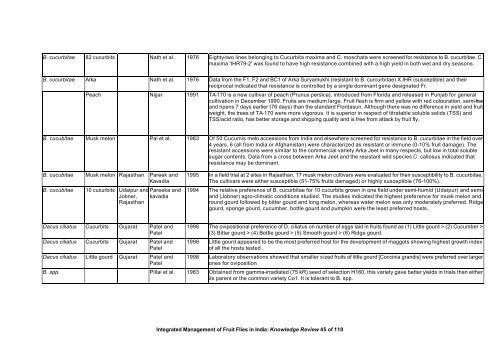“Key Informant Survey” of Production, Value, Losses and ... - DfID
“Key Informant Survey” of Production, Value, Losses and ... - DfID
“Key Informant Survey” of Production, Value, Losses and ... - DfID
Create successful ePaper yourself
Turn your PDF publications into a flip-book with our unique Google optimized e-Paper software.
B. cucurbitae 82 cucurbits Nath et al. 1976 Eighty-two lines belonging to Cucurbita maxima <strong>and</strong> C. moschata were screened for resistance to B. cucurbitae. C.<br />
maxima 'IHR79-2' was found to have high resistance combined with a high yield in both wet <strong>and</strong> dry seasons.<br />
B. cucurbitae Arka Nath et al. 1976 Data from the F1, F2 <strong>and</strong> BC1 <strong>of</strong> Arka Suryamukhi (resistant to B. curcurbitae) X IHR (susceptible) <strong>and</strong> their<br />
reciprocal indicated that resistance is controlled by a single dominant gene designated Fr.<br />
Peach Nijjar 1991 TA-170 is a new cultivar <strong>of</strong> peach (Prunus persica), introduced from Florida <strong>and</strong> released in Punjab for general<br />
cultivation in December 1990. Fruits are medium large. Fruit flesh is firm <strong>and</strong> yellow with red colouration, semi-free<br />
<strong>and</strong> ripens 7 days earlier (76 days) than the st<strong>and</strong>ard Flordasun. Although there was no difference in yield <strong>and</strong> fruit<br />
weight, the trees <strong>of</strong> TA-170 were more vigorous. It is superior in respect <strong>of</strong> titratable soluble solids (TSS) <strong>and</strong><br />
TSS/acid ratio, has better storage <strong>and</strong> shipping quality <strong>and</strong> is free from attack by fruit fly.<br />
B. cucubitae Musk melon Pal et al. 1983 Of 50 Cucumis melo accessions from India <strong>and</strong> elsewhere screened for resistance to B. cucurbitae in the field over<br />
4 years, 6 (all from India or Afghanistan) were characterized as resistant or immune (0-10% fruit damage). The<br />
resistant accessions were similar to the commercial variety Arka Jeet in many respects, but low in total soluble<br />
sugar contents. Data from a cross between Arka Jeet <strong>and</strong> the resistant wild species C. callosus indicated that<br />
resistance may be dominant.<br />
B. cucubitae Musk melon Rajasthan Pareek <strong>and</strong><br />
Kavadia<br />
B. cucubitae 10 cucurbits Udaipur <strong>and</strong> Pareeka <strong>and</strong><br />
Jobner,<br />
Rajasthan<br />
kavadia<br />
Dacus ciliatus Cucurbits Gujarat Patel <strong>and</strong><br />
Patel<br />
Dacus ciliatus Cucurbits Gujarat Patel <strong>and</strong><br />
Patel<br />
Dacus ciliatus Little gourd Gujarat Patel <strong>and</strong><br />
Patel<br />
1995 In a field trial at 2 sites in Rajasthan, 17 musk melon cultivars were evaluated for their susceptibility to B. cucurbitae.<br />
The cultivars were either susceptible (51-75% fruits damaged) or highly susceptible (76-100%).<br />
1994 The relative preference <strong>of</strong> B. cucurbitae for 10 cucurbits grown in one field under semi-humid (Udaipur) <strong>and</strong> semiarid<br />
(Jobner) agro-climatic conditions studied. The studies indicated the highest preference for musk melon <strong>and</strong><br />
round gourd followed by bitter gourd <strong>and</strong> long melon, whereas water melon was only moderately preferred. Ridge<br />
gourd, sponge gourd, cucumber, bottle gourd <strong>and</strong> pumpkin were the least preferred hosts.<br />
1998 The ovipositional preference <strong>of</strong> D. ciliatus on number <strong>of</strong> eggs laid in fruits found as (1) Little gourd > (2) Cucumber ><br />
(3) Bitter gourd > (4) Bottle gourd > (5) Smooth gourd > (6) Ridge gourd.<br />
1998 Little gourd appeared to be the most preferred host for the development <strong>of</strong> maggots showing highest growth index<br />
<strong>of</strong> all the hosts tested .<br />
1998 Laboratory observations showed that smaller sized fruits <strong>of</strong> little gourd [Coccinia gr<strong>and</strong>is] were preferred over larger<br />
ones for oviposition<br />
B. spp. Pillai et al. 1983 Obtained from gamma-irradiated (75 kR) seed <strong>of</strong> selection H160, this variety gave better yields in trials than either<br />
its parent or the common variety Co1. It is tolerant to B. spp.<br />
Integrated Management <strong>of</strong> Fruit Flies in India: Knowledge Review 45 <strong>of</strong> 110

















